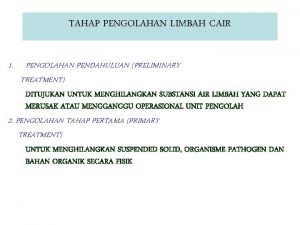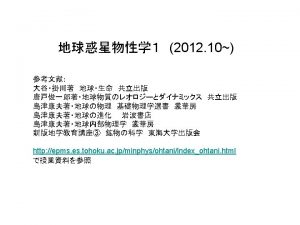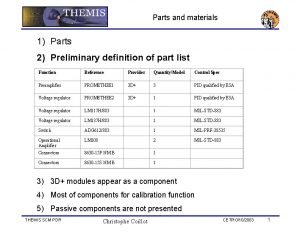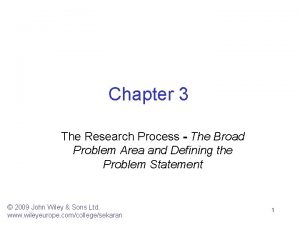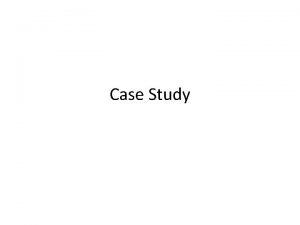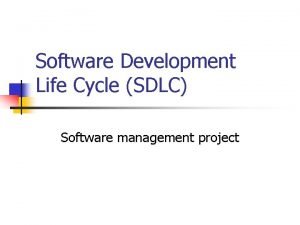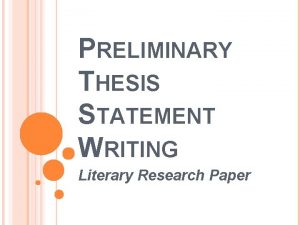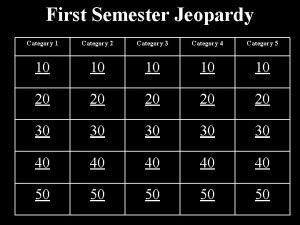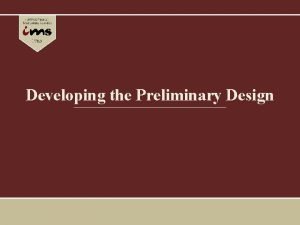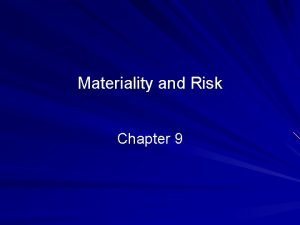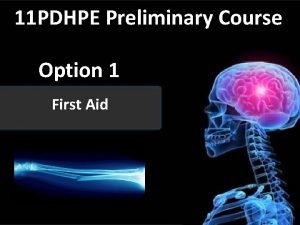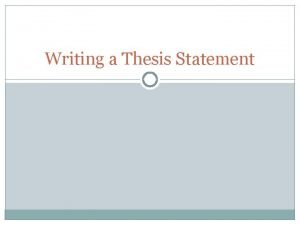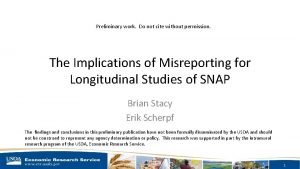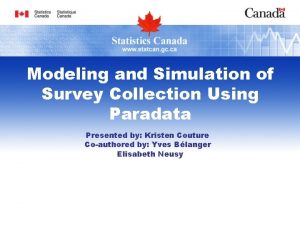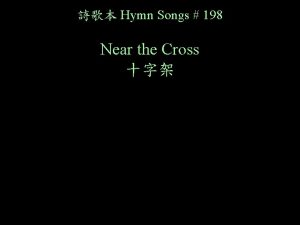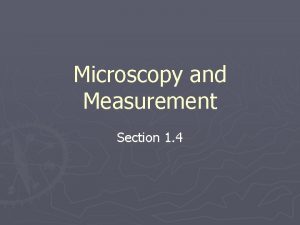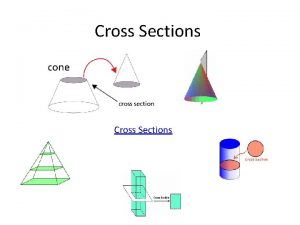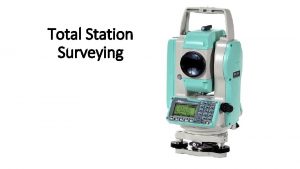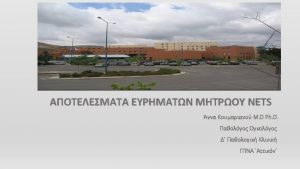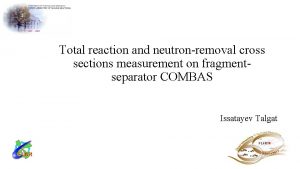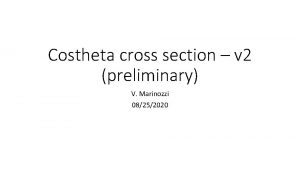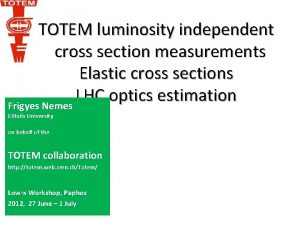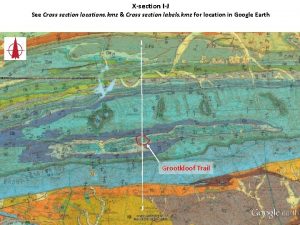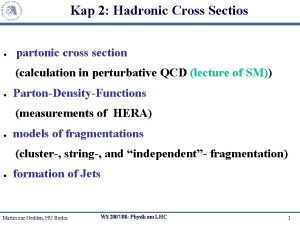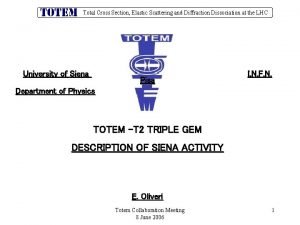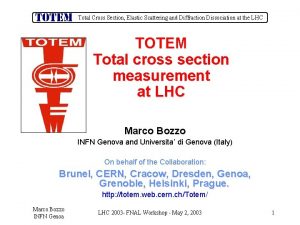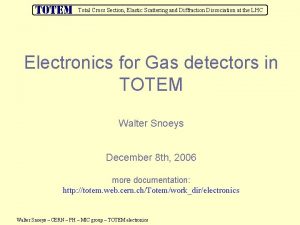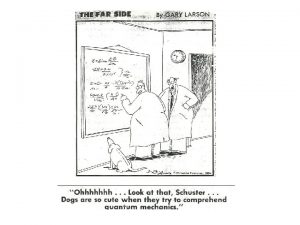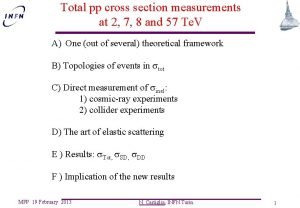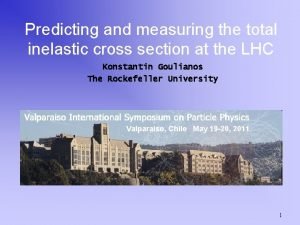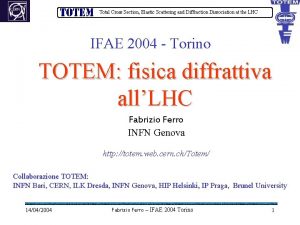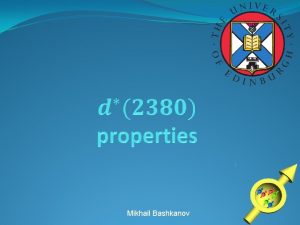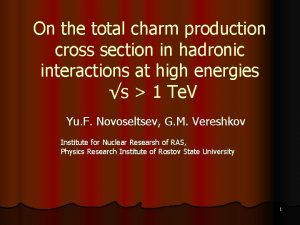Preliminary measurement of the total cross section in













































![Fit range dependence Nominal fit range [0. 01, 0. 1], variation by ± 0. Fit range dependence Nominal fit range [0. 01, 0. 1], variation by ± 0.](https://slidetodoc.com/presentation_image/d203a910323c5fdedf68ddf869f92271/image-46.jpg)



![Results for alternative models σtot [mb] Reference 95. 35 ± 1. 30 - 95. Results for alternative models σtot [mb] Reference 95. 35 ± 1. 30 - 95.](https://slidetodoc.com/presentation_image/d203a910323c5fdedf68ddf869f92271/image-50.jpg)















- Slides: 65

Preliminary measurement of the total cross section in pp collisions at √s=7 Te. V with the ALFA subdetector of ATLAS Hasko Stenzel, JLU Giessen on behalf of the ATLAS Collaboration Conf. Note: http: //cds. cern. ch/record/1740971

Outline • Introduction • Experimental setup: ALFA • Data analysis • Differential elastic cross section • Theoretical prediction, fits and cross-checks • Results for σtot • Conclusion CERN seminar 22. 07. 2014 Hasko Stenzel 2

Introduction The total pp X cross section is a fundamental quantity setting the scale for all interaction probabilities, it should be measured at each new collider or centre-ofmass energy. The total cross section can‘t be calculated in perturbative QCD, but still can be measured, e. g. using the Optical Theorem: p 4 p 1 θ p 2 p 3 A number of bounds and constraints can be placed on σtot: • Froissart-Martin bound: σtot doesn’t rise faster than ln 2 s • Black disk limit: • Pomeranchuk theorem: CERN seminar 22. 07. 2014 Hasko Stenzel 3

Rise of σtot at ISR At the ISR a rise of the total cross section was first observed. U. Amaldi et al. , Phys. Lett. B 44 (1973) 192 S. R. Amendolia et al. , Phys. Lett. B 44 (1973) 119 Would the total cross section continue to rise with ln(s) or rather ln 2(s)? CERN seminar 22. 07. 2014 Hasko Stenzel 4

Luminosity and total cross section The optical theorem can be used together with the luminosity to determine the total cross section (method used by ATLAS): Luminosity-dependent method ρ taken from model extrapolation If the total inelastic yield is measured simultaneously with the elastic yield, the luminosity can be eliminated: Luminosityindependent method If the elastic and inelastic cross sections are measured separately: ρ-independent method CERN seminar 22. 07. 2014 Hasko Stenzel 5

The differential elastic cross section At small |t| the cross section decreases exponentially The nuclear slope parameter B increases with energy shrinkage of forward cone At large |t| a diffractive minimum appears “the dip”, its position is energy dependent ATLAS range At very large |t| the distribution follows a power law At very small t the contribution from Coulomb interaction becomes important D. Bernard et al. , UA 4 Collaboration, Phys. Lett. B 171 (1986) 142 CERN seminar 22. 07. 2014 Hasko Stenzel 6

Available measurements At the LHC first measurements were done by TOTEM: σtot = 98. 6± 2. 2 mb (7 Te. V) σtot = 101. 7± 2. 9 mb (8 Te. V) Measurements were performed by cosmic ray observatories at yet higher energies, using air showers and transforming proton-air cross sections into pp cross section with Glauber models. CERN seminar 22. 07. 2014 Hasko Stenzel 7

Experimental setup: ALFA CERN seminar 22. 07. 2014 Hasko Stenzel 8

Elastic scattering with ATLAS-ALFA Roman Pot detectors at 240 m from IP 1 approaching the beam during special runs at high β*. In October 2011 ALFA had the special run 191373 with β*=90 m and recorded 800 k good selected elastic events used for the analysis of the total cross section and the nuclear slope B. CERN seminar 22. 07. 2014 Hasko Stenzel 9

The ALFA detector in a nutshell ALFA is a scintillating fibre tracker, 10 double-sided modules with 64 fibres in uvgeometry. Resolution ~30µm. Special overlap detectors to measure the distance between upper and lower detectors. alignment CERN seminar 22. 07. 2014 v fibres u fibres Hasko Stenzel 10

Beam optics and properties • Special optics high β* =90 m • Small emittance 2 -3µm • Small divergence ~3µrad good t-resolution • Phase advance of βy=90° parallel-to-point focusing • Phase advance of βx≈180° y* IP parallel-to-point focusing ydet y * Leff • Only one pair of colliding bunches at 7 1010 p • More pilot bunches / unpaired bunches • L≈1027/cm 2/s, µ ≈0. 035 CERN seminar 22. 07. 2014 Hasko Stenzel 11

Hit pattern at ALFA Hit pattern in one station, before elastic event selection. Pattern shape is caused by beam optics Leffy=270 m Leffx=13 m CERN seminar 22. 07. 2014 Hasko Stenzel 12

Data Analysis CERN seminar 22. 07. 2014 Hasko Stenzel 13

Alignment Rough centering and alignment through scraping Offsets and rotations are obtained from elastic data Distance measurement from OD detectors Vertical offsets wrt beam center are obtained by assuming efficiency-corrected equal yields in upper and lower detectors • Final vertical detector positions are related one station as reference and using optics lever arm ratios to predict the positions from inner to outer detectors • Vertical position precision is ~80µm • • CERN seminar 22. 07. 2014 Hasko Stenzel 14

Measurement of t Measure elastic track positions at ALFA to get the scattering angle and thereby the t-spectrum dσ/dt p=beam momentum, θ*=scattering angle To calculate the scattering angle from the measured tracks we need the beam optics, i. e. the transport matrix elements. CERN seminar 22. 07. 2014 In the simplest case (high β*, phase advance 90°, parallel-to-point focusing) Hasko Stenzel 15

Different reconstruction methods • subtraction method: • local angle method: • local subtraction: • lattice method: CERN seminar 22. 07. 2014 Hasko Stenzel 16

• • Event selection first level elastic trigger data quality cuts apply geometrical acceptance cuts apply elastic selection based on back-to-back topology and background selection cut elastic selection: y Avs C-side CERN seminar 22. 07. 2014 background rejection Hasko Stenzel 17

Trigger efficiency Elastic trigger: Coincidence of A- and C-side in elastic configuration, using a local OR. Data were also recorded with a looser trigger condition requiring any of the 8 detectors to fire: trigger efficiency = 99. 96± 0. 01 %. For the selected data period the DAQ life fraction was 99. 7± 0. 01%. CERN seminar 22. 07. 2014 Hasko Stenzel 18

Background Two ways to estimate the irreducible background under the elastic peak: • Counting events in the anti-golden configuration (nominal method) • Reconstructing the vertex distribution in x through the lattice, where background appears in non Gaussian tails, fraction estimated with background templates obtained from data (for systematics) Arm 2 Arm 1 golden anti-golden CERN seminar 22. 07. 2014 Hasko Stenzel 19

Background Vertex method anti-golden Background fraction is 0. 5 ± 0. 25 % dominated by halo protons CERN seminar 22. 07. 2014 Hasko Stenzel 20

Simulation: acceptance & unfolding • Using PYTHIA 8 as elastic scattering generator • Beam transport IP RP (matrix transport / Mad. X PTC) • Fast detector response parameterization tuned to data Comparison of data and MC for positions at ALFA CERN seminar 22. 07. 2012 Hasko Stenzel 21

Acceptance is given by geometry, mostly by vertical cuts. CERN seminar 22. 07. 2012 Hasko Stenzel 22

Resolution of different methods Subtraction method has by far best resolution, dominated by beam divergence. All other methods suffer from a poor local angle resolution. CERN seminar 22. 07. 2012 Hasko Stenzel 23

Unfolding resolution effects Transition matrix from true value of t to reconstructed value of t used as input for IDS unfolding. B. Malaescu ar. Xiv: 1105. 3107 CERN seminar 22. 07. 2012 Hasko Stenzel 24

Impact of unfolding Systematic uncertainty evaluated with a data-driven closure test, based on the small difference between data and MC at reconstruction level. CERN seminar 22. 07. 2012 Hasko Stenzel 25

Reconstruction efficiency Fully data-driven method, using a tag-and-probe approach exploiting elastic back-to-back topology and high trigger efficiency. Arm 1 Arm 2 Efficiency εrec 0. 898 0. 880 Uncertainty ± 0. 006 ± 0. 009 CERN seminar 22. 07. 2014 Hasko Stenzel Slightly different efficiency in the two arms material budget is different. 26

Reconstruction efficiency Several different topologies contribute to the inefficiency, which is mainly caused by shower developments. 4/4 3/4 case: 2/3 of the losses Ensure ¾ events are elastics Check shape CERN seminar 22. 07. 2014 Check t-independence of reconstruction efficiency. Hasko Stenzel 27

Reconstruction efficiency 2/4 case (≈30% of the losses): ensure these events are inside the acceptance and elastics (not background, e. g. from SD+Halo). Peaks observed resulting from showers in RP window and beam screen: These events are outside of acceptance and removed. CERN seminar 22. 07. 2014 Distribution of remaining 2/4 events are fit to estimate the background contribution with BGenhances templates. Hasko Stenzel 28

Luminosity Dedicated analysis for this lowluminosity run: Based on BCM with LUCID and vertex counting as cross-check. Systematics: • vd. M calibration 1. 5% • BCM drift 0. 25% • Background 0. 2% • Time stability 0. 7% • Consistency 1. 6% L=78. 7± 1. 9 µb-1 Systematic uncertainty 2. 3% CERN seminar 22. 07. 2014 Hasko Stenzel 29

Beam optics From the elastic data several constraints were recorded to fine-tune the transport matrix elements. These are obtained from correlations in the positions/angles: y inner vs outer x left vs right Lever arm ratio CERN seminar 22. 07. 2014 Hasko Stenzel 30

Beam optics scaling factors A second class of constraints is obtained from correlations of the reconstructed scattering angle using different methods. These constraints are derived using design 90 m optics and indicate the amount of scaling needed in order to equalize the scattering angle measurement from different methods. CERN seminar 22. 07. 2014 Measure the difference in reconstructed scattering angle in horizontal plane between subtraction and local angle method vs Θ*x from subtraction scaling factor R(M 12/M 22). Hasko Stenzel 31

beam optics fit 14 constraints are combined in a fit of the relevant beam optics parameters. Most important are the strengths of the inner triplet quadrupoles. Quadrupoles Q 1, Q 3 and Q 2 were produced at different sites fit an intercalibration offset That is the simplest but not unique solution effective optics CERN seminar 22. 07. 2014 Small correction to optics model, 3‰ to inner triplet magnet strength. Δk. Q 1 Q 3[‰] Beam 1 2. 88± 0. 15 Hasko Stenzel Beam 2 3. 13± 0. 12 32

Differential elastic cross section CERN seminar 22. 07. 2014 Hasko Stenzel 33

The differential elastic cross section Fully corrected t-spectra in the two arms are combined and divided by the luminosity to yield the differential elastic cross section. A: acceptance(t) M: unfolding procedure (symbolic) N: selected events B: estimated background εreco: reconstruction efficiency εtrig: trigger efficiency εDAQ: dead-time correction Lint: luminosity CERN seminar 22. 07. 2014 Hasko Stenzel 34

Systematic uncertainties for dσ/dt • luminosity: ± 2. 3% • beam energy: ± 0. 65% • background 0. 5 ± 0. 25 % • optics: quadrupole strength ± 1‰, Q 5, 6 -2‰ magnet mis-alignment, optics fit errors, beam transport, ALFA constraints varied by ± 1σ • residual crossing angle ± 10 <mrad CERN seminar 22. 07. 2014 More than 500 alternative optics models were used to reconstruct the t -spectrum and calculate unfolding & acceptance corrections. Hasko Stenzel 35

Systematic uncertainties for dσ/dt reco. eff. : ± 0. 8% emittance: ± 10% detector resolution: ± 15% physics model for simulation: B=19. 5 ± 1 Ge. V-2 • unfolding: data driven closure test • alignment uncertainties propagated • track reconstruction cut variation • • CERN seminar 22. 07. 2014 Most important experimental systematic uncertainties: Luminosity and beam energy. Systematic shifts are included in the fit of the total cross section. Hasko Stenzel 36

Theoretical predictions CERN seminar 22. 07. 2014 Hasko Stenzel 37

The elastic scattering amplitude is usually expressed as a sum of the nuclear amplitude and the Coulomb amplitude: The nuclear amplitude is the dominant contribution in the differential cross section with a term quadratic in σtot and an essentially exponential shape with slope B. The Coulomb term is important at small t, but the Coulomb-nuclear interference term has a non-negligible contribution inside the accessible t-range. Differential elastic cross section with the Coulomb phase Φ. CERN seminar 22. 07. 2014 Hasko Stenzel 38

Theoretical prediction The theoretical prediction used to fit the elastic data consists of the Coulomb term, the Coulomb-Nuclear-Interference term and the dominant Nuclear term. Coulomb CNI Nuc. Proton dipole form factor Coulomb phase CERN seminar 22. 07. 2014 Hasko Stenzel 39

modified χ2 to account for systematics D: data, T: theoretical prediction V: statistical covariance matrix δ: systematic shift k in t spectrum β: nuisance parameter for syst. shift k ε: t-independent normalization uncertainty (luminosity, reco efficiency) α: nuisance parameter for normalization uncertainties CERN seminar 22. 07. 2014 Hasko Stenzel 40

Results for σtot CERN seminar 22. 07. 2014 Hasko Stenzel 41

exp. +stat. Fit Results The fit includes experimental systematic uncertainties in the χ. The fit quality is good: χ2/Ndof=7. 4/16. The fit range is set to –t[0. 01, 0. 1] Ge. V 2, where possible deviations from exponential form of the nuclear amplitude are expected to be small. CERN seminar 22. 07. 2014 Hasko Stenzel 42

theoretical/extrapolation uncertainties • uncertainty in ρ = 0. 14 ± 0. 008 (COMPETE) • variation of the proton electric form factor • variation of the Coulomb phase • in order to probe possible non-exponential contributions to the nuclear amplitude a variation of the upper end of the fit range is carried out from 0. 15 Ge. V 2 , based on theoretical considerations. CERN seminar 22. 07. 2014 Hasko Stenzel 43

The electric form factor Dipole: New measurements from A 1 using low-energy electronproton scattering at MAMI. J. C. Bernauer et al. A 1 Collaboration, ar. Xiv: 1307: 6227 Largest deviation is observed between Dipole and Double. Dipole very small impact on total cross section. CERN seminar 22. 07. 2014 Hasko Stenzel 44

The Coulomb phase West and Yennie: Alternative parameterizations were proposed by Cahn R. N. Cahn, Z. Phys. C 15 (1982) 253 and by Kohara et al. (KFK) A. K. Kohara, Eur. Phys. J. C 73 (2013) 2326 Phase has a small impact on the CNI term, which is small very small impact on total cross section. CERN seminar 22. 07. 2014 Hasko Stenzel 45
![Fit range dependence Nominal fit range 0 01 0 1 variation by 0 Fit range dependence Nominal fit range [0. 01, 0. 1], variation by ± 0.](https://slidetodoc.com/presentation_image/d203a910323c5fdedf68ddf869f92271/image-46.jpg)
Fit range dependence Nominal fit range [0. 01, 0. 1], variation by ± 0. 05, as advocated by KMR V. A. Khoze et al. , Eur. Phys. J. C 18 (2000) 167 Systematic uncertainty is derived from the endpoints of the fit range variation. CERN seminar 22. 07. 2014 Hasko Stenzel 46

Cross checks (1) Comparison of different treconstruction methods consistent results Using only statistical uncertainties in the fit, i. e. w/o nuisance parameters Statistical error only Instead of unfolding the data we folded theoretical prediction to the raw data consistent fit results CERN seminar 22. 07. 2014 Hasko Stenzel 47

Cross checks (2) Determination of the differential elastic cross section in each independent arm: consistent, even within statistical errors. Split the run in periods (≈20 min. , 80 k events) no timestructure (stat. error ≈ 0. 5 mb) CERN seminar 22. 07. 2014 Hasko Stenzel 48

Alternative models for the nuclear amplitude • several models for the nuclear amplitude featuring a non-exponential behaviour are tested • all models come with more parameters and are intended to be extended to larger t [0. 01, 0. 3] • restrict to parametric models allowing to fit the total cross section 1. fit with Ct 2 term 2. fit with sqrt(t) term 3. SVN model 4. BP model 5. BSW model CERN seminar 22. 07. 2014 Hasko Stenzel 49
![Results for alternative models σtot mb Reference 95 35 1 30 95 Results for alternative models σtot [mb] Reference 95. 35 ± 1. 30 - 95.](https://slidetodoc.com/presentation_image/d203a910323c5fdedf68ddf869f92271/image-50.jpg)
Results for alternative models σtot [mb] Reference 95. 35 ± 1. 30 - 95. 49 ± 1. 27 M. M. Block et al. , Czech. J. Phys. 40 (1990) 164. 96. 03 ± 1. 31 O. V. Selyugin, Nucl. Phys. A 922 (2014) 180. SVM 94. 90 ± 1. 23 A. K. Kohara et al. , Eur. Phys. J. C 73 (2013) 2326. BP 95. 49 ± 1. 54 R. J. N. Phillips et al. , Phys. Lett. B 46 (1973) 412. D. A. Fagundes et al. , Phys. Rev. D 88 (2013) 094019. BSW 95. 53 ± 1. 38 C. Bourrely et al. , Eur. Phys. J. C 71 (2011) 1601. Nominal Only statistical and experimental systematic uncertainties on dσ/dt are included in the profile fit. The RMS of all the models tested is in good agreement with the assigned extrapolation uncertainty of 0. 4 mb. CERN seminar 22. 07. 2014 Hasko Stenzel 50

Results Standard model cross section measurements by ATLAS CERN seminar 22. 06. 2014 Energy evolution of σtot and σel Hasko Stenzel 51

Energy evolution of B private compilation Increase of B compatible with a 2 nd order polynomial in ln(s). Parameters from: V. A. Schegelsky and M: G: Ryskin , Phys. Rev. D 85 (2012) 0940243 CERN seminar 22. 06. 2014 Hasko Stenzel 52

Comparison with TOTEM The ATLAS measurement is 3. 2 mb lower than TOTEM, the difference corresponds to 1. 3 σ, assuming uncorrelated uncertainties. ATLAS σtot = 95. 4± 1. 4 mb B = 19. 7 ± 0. 3 Ge. V-2 TOTEM σtot = 98. 6± 2. 2 mb B = 19. 9 ± 0. 3 Ge. V-2 Comparison of results using the luminosity-dependent method. The luminosity uncertainty for ATLAS is ± 2. 3% and for TOTEM ± 4%, it enters in the uncertainty of σtot with a factor 0. 5. CERN seminar 22. 06. 2014 Hasko Stenzel 53

Further derived quantities Elastic cross section from the integrated fit-function (nuclear part) The observed elastic cross section inside the fiducial volume: The optical point: CERN seminar 22. 06. 2014 Hasko Stenzel 54

The inelastic cross section The total inelastic cross section σinel is obtained by subtraction of the elastic cross section from the total cross section. CERN seminar 22. 07. 2014 Hasko Stenzel 55

Conclusion and outlook ATLAS has performed a preliminary measurement of the total cross section at the LHC at √s=7 Te. V from elastic scattering measured with the ALFA detector in good agreement with previous measurements from TOTEM. Our measurement of reached at the LHC indicates that the black-disk limit is not We have collected in 2012 at √s=8 Te. V more data with β*=90 m optics and with β*=1 km optics, the latter enables access to yet smaller values of t in the CNI region. During the LHC shutdown a substantial consolidation of the ALFA detector achieved (RF protection, optimized placement of Roman Pot stations), and we are looking forward to collect more elastic and diffractive data in the LHC run 2. CERN seminar 22. 07. 2014 Hasko Stenzel 56

Back Up CERN seminar 22. 07. 2014 Hasko Stenzel 57

Transport matrix ALFA phase advance vertical: ψ=90° horizontal ψ=185° CERN seminar 22. 07. 2014 beam transport matrix from optical functions Hasko Stenzel IP 58

Rescaling factors Scaling factor based on the isotropy of elastic scattering, i. e. scattering angle distribution is flat in phi, density in x must be the same as in y. CERN seminar 22. 07. 2014 Hasko Stenzel 59

Pulls of the fit to dσ/dt Pulls of the fit with respect to the data, taking into account fitted nuisance parameters adjusting data and theory. CERN seminar 22. 07. 2014 Hasko Stenzel 60

Results for 4 different methods CERN seminar 22. 07. 2014 Hasko Stenzel 61

Systematic uncertainties for dσ/dt Systematic shifts used in the profile fit CERN seminar 22. 07. 2014 Hasko Stenzel 62

Systematic uncertainties for dσ/dt Systematic shifts used in the profile fit CERN seminar 22. 07. 2014 Hasko Stenzel 63

The t-spectrum Reconstructed tspectrum for different methods before corrections. Difference between methods understood as resulting from different resolutions inducing different unfolding corrections. CERN seminar 22. 07. 2014 Hasko Stenzel 64

Nuisance parameters The nuisance parameters are expected with a mean value of 0 and an uncertainty of ± 1. The statistical uncertainty of the physics parameters σtot and B are obtained from simulated pseudo-experiments: CERN seminar 22. 07. 2014 Hasko Stenzel 65
 Total no one else
Total no one else Activo promedio
Activo promedio Total revenues minus total costs equals
Total revenues minus total costs equals Total revenues minus total costs equals
Total revenues minus total costs equals Total revenues minus total costs equals
Total revenues minus total costs equals Total revenue minus total expenses
Total revenue minus total expenses Preliminary budget
Preliminary budget Preliminary treatment adalah
Preliminary treatment adalah Preliminary survey audit
Preliminary survey audit Preliminary reference earth model
Preliminary reference earth model Preliminary design review example
Preliminary design review example Preliminary material
Preliminary material Mla style outline
Mla style outline Preliminary interview
Preliminary interview Broad problem area adalah
Broad problem area adalah Gayne corporation's contribution margin ratio
Gayne corporation's contribution margin ratio Fly leaf 1
Fly leaf 1 3 p's of communication
3 p's of communication Systems development life cycle
Systems development life cycle Preliminary thesis examples
Preliminary thesis examples Preliminary rifle instruction
Preliminary rifle instruction Arrt preliminary score change
Arrt preliminary score change Image strategies
Image strategies A preliminary synopsis of a film's action is called
A preliminary synopsis of a film's action is called Determine junktrader’s preliminary net income.
Determine junktrader’s preliminary net income. Milady chapter 20 test
Milady chapter 20 test Preliminary business plan
Preliminary business plan Preliminary prototype
Preliminary prototype Preliminary audit procedures
Preliminary audit procedures Preliminary outline
Preliminary outline Pre softening milady
Pre softening milady Waterfall approach vs shower approach
Waterfall approach vs shower approach Ihrm training and development
Ihrm training and development Preliminary objectives
Preliminary objectives Process of advertising research
Process of advertising research Preliminary statement definition
Preliminary statement definition Preliminary review definition
Preliminary review definition Materiality is a relative rather than an absolute concept
Materiality is a relative rather than an absolute concept Haccp stands for
Haccp stands for Preliminary marketing plan
Preliminary marketing plan Pdr preliminary design review
Pdr preliminary design review First aid situational analysis
First aid situational analysis Thesis statement fill in the blank
Thesis statement fill in the blank Preliminary ruling
Preliminary ruling Preliminary design review template
Preliminary design review template Introduction about recruitment and selection
Introduction about recruitment and selection Preliminary works cited
Preliminary works cited Preliminary research
Preliminary research Reading pet part 6
Reading pet part 6 Preliminary results example
Preliminary results example Preliminary cooking and flavoring
Preliminary cooking and flavoring Introduction to sdlc
Introduction to sdlc Preliminary assessment
Preliminary assessment Preliminary test
Preliminary test Preliminary outline speech
Preliminary outline speech Test cross and back cross
Test cross and back cross Test cross and back cross with example
Test cross and back cross with example Example of complete dominance
Example of complete dominance Monohybrid vs dihybrid
Monohybrid vs dihybrid In the cross, in the cross be my glory ever
In the cross, in the cross be my glory ever Lingualized occlusion vs balanced occlusion
Lingualized occlusion vs balanced occlusion Chapter 8 section 1 what are earthquakes answer key
Chapter 8 section 1 what are earthquakes answer key Section 2 standards of measurement answer key
Section 2 standards of measurement answer key Microscopy and measurement section 1-4 review
Microscopy and measurement section 1-4 review Hình ảnh bộ gõ cơ thể búng tay
Hình ảnh bộ gõ cơ thể búng tay Lp html
Lp html







